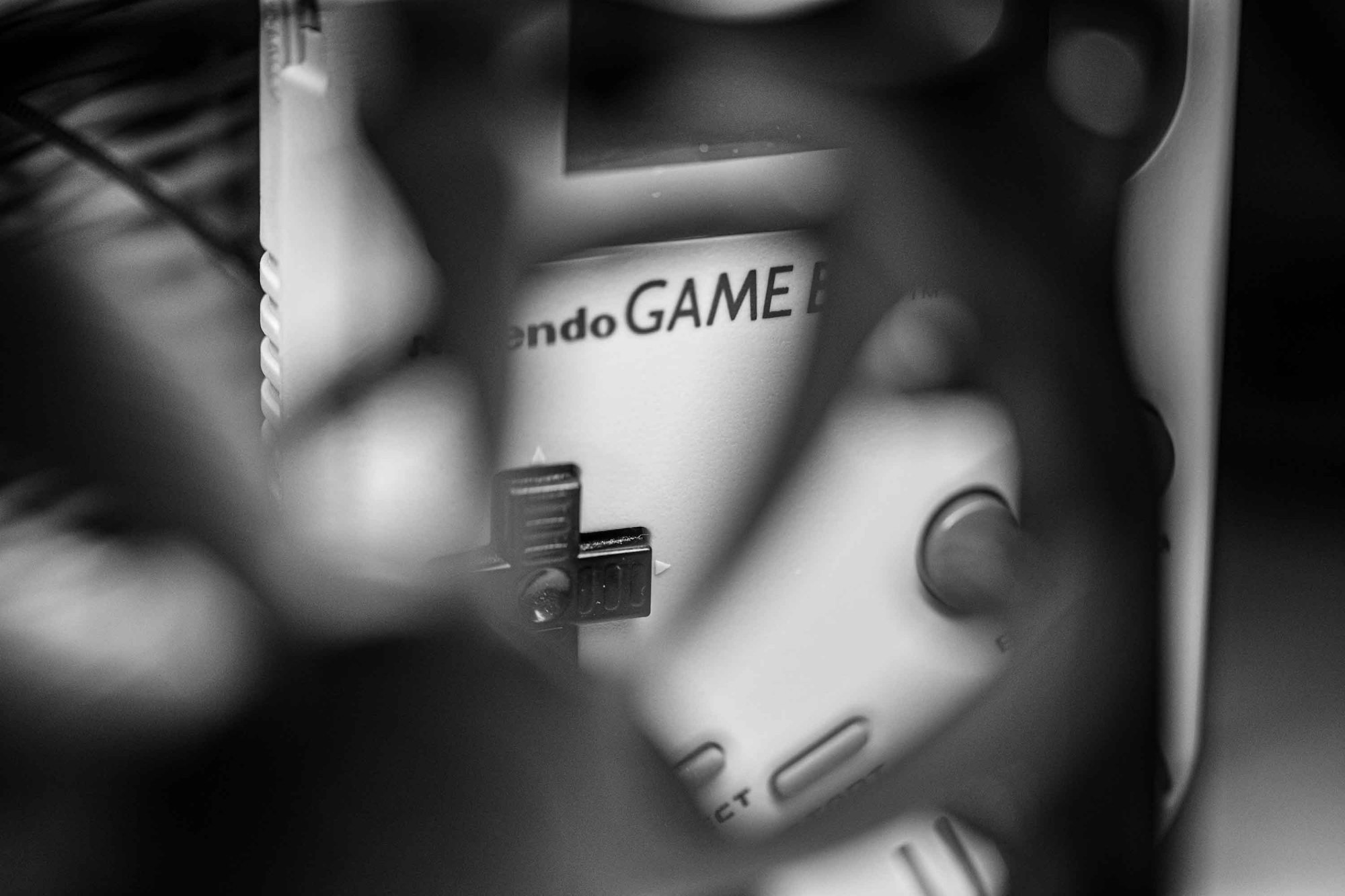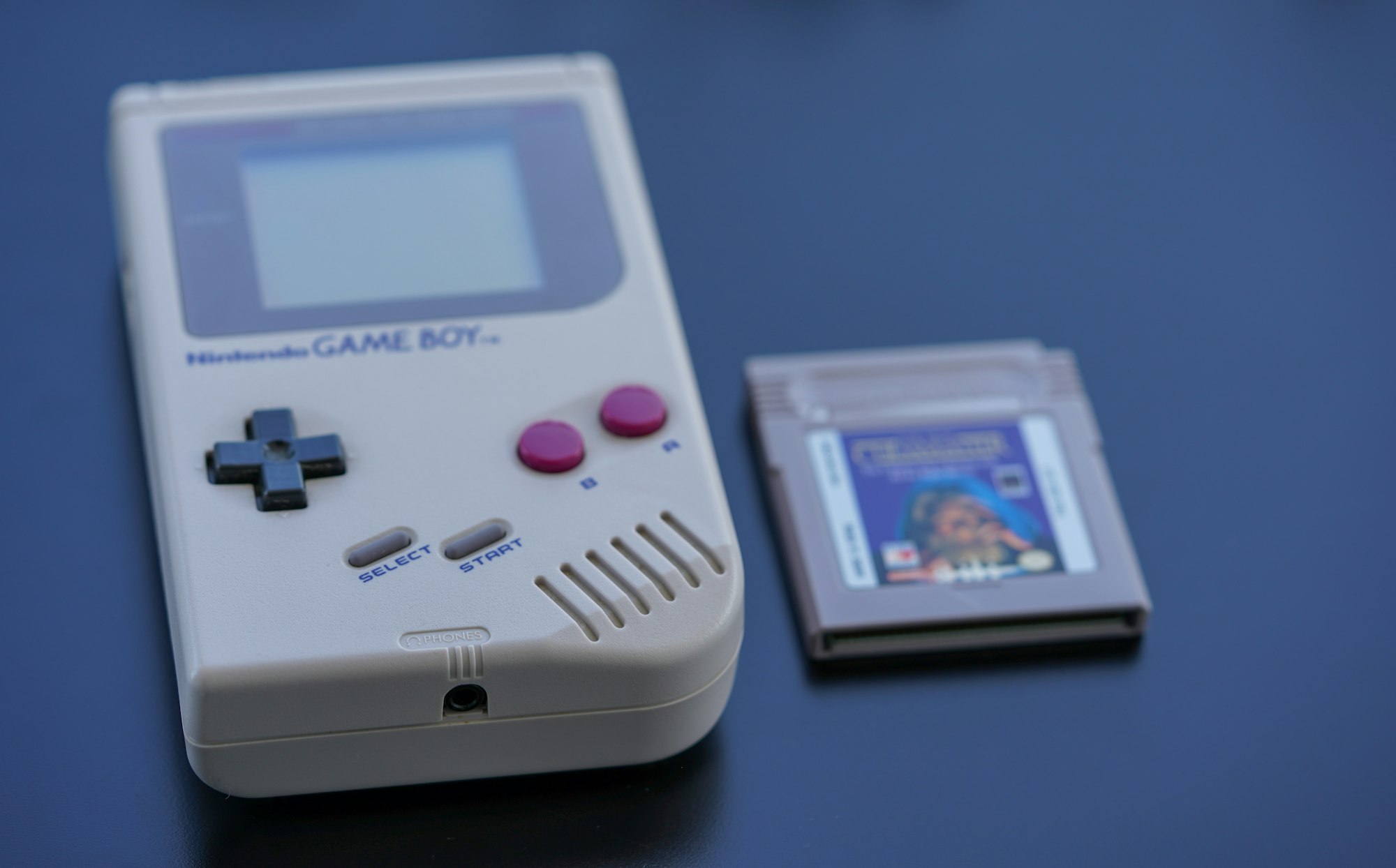Monochrome Fantasia: Life in the Age of the Game Boy
The third best-selling video game system of all time never got the respect it deserved

If you’re not part of the hardcore retro scene, you might not have heard of the Analogue Pocket. The device, one in a new wave of FPGA-based handhelds, is compatible with all games from the Game Boy family, as well as a range of other systems through the use of adapters. The idea is to replicate the experience of playing a Game Boy as accurately as possible while also incorporating the features that modern consumers expect. That fidelity doesn’t come cheap, but for the serious enthusiast it’s as close to time travel as one can get.
The interest in devices such as these is a sound reminder that there is still some passion for the old Game Boy. The family of systems (including the Game Boy Color) sold 118 million units, making it Nintendo’s second-best selling system (after the DS line), the second-best selling handheld system and the third-best selling game system of all time.

Yet the Game Boy is — and has always been — treated as something of a sideshow. It was a supporting act to the main attractions that were the NES and SNES, even though the Game Boy outsold both combined. Today, the Game Boy is brought up on anniversaries as a device that was revolutionary in some vague sense, then quickly pushed back into the closet.
I received my Game Boy at age 4. To me, this was not a “revolutionary” device that pioneered mobile gaming, or an economic marvel that kept Nintendo afloat through the lean years. It was simply a child’s electronic companion.
So let’s talk about it.
From TV to “pocket”
1989 and 1990 were landmark years for video games, and arguably for consumer electronics in general. These two years saw the release of a series of ambitious new devices — machines meant to take the video game experience, which had only been introduced to the home a decade and a half prior, and make them portable. The most notable systems from this period were the Nintendo Game Boy, Atari Lynx, NEC TurboExpress, and Sega Game Gear.
These devices weren’t exactly the first of their kind. Handheld electronic games had existed since the mid-70s in the form of simple devices such as the Mattel’s Auto Race and Parker Brothers’ Merlin the Electronic Wizard. The availability of cheap LCD components in the ‘80s resulted in a flood of low-cost handhelds, including Nintendo’s Game & Watch line. But as anyone who’s ever gone hands-on will tell you, they certainly aren’t the equivalent to what one would see in the arcades or from a home console made by someone like Atari. The new systems were far closer to what consumers were coming to expect.

The Game Boy was the first out of the gate. On April 21, 1989, consumers were finally able to wrap their hands around the future of video games, stepping into a market that Nintendo was essentially creating from scratch. Stylistically, it was a product of its time — a chunky electronic brick with a gray case destined to be plastered over with stickers, one speaker, a pea-green display with a flickery battery light that might tell you something if you closed one eye and squinted at it. By modern standards, it’s not pretty. By the standards of the day, it was a miracle.
The portability of the Game Boy was a bit of a myth. Yes, it will travel a lot better than a portable TV, Super NES, and all of the cables needed to hook them up. It probably wasn’t going to fit in your pocket, though, at least not unless you were wearing cargo shorts a few years before they became popular. I carried mine in what amounted to a scaled-down, child-sized attache case, sporting lots of room for cartridges and accessories. You definitely had a few accessories, too — an external light to play in the car after dark, an AC adapter for long sessions at home, and maybe even a Game Genie that made the device top-heavy and wore out your wrists if you used it for more than a half-hour.
Quibbles aside, the merits of a portable game console were immediately obvious. As a child, it’s not uncommon to be dragged places one would rather not go; in my case, that was sporting events. American football is a game I have always found boring, and the ability to play Kirby’s Dream Land on one of the many occasions I was forced to go to a game was a minor blessing.
One such afternoon, the game was delayed on account of rain, leaving most of the attendees without anything to do. The lady in front of me turned around and made note of the Game Boy. “I kind of wish we all had one,” she said.
Looking back, Nintendo’s success in the handheld market seems very unlikely, as the Game Boy certainly seems like the loser of those first four major systems. The other three devices were technically superior (with backlit color screens, for example) and/or had special added features that Nintendo couldn’t match. Critics of the time commented on the primitive nature of the Game Boy compared to its competition, asking how long Nintendo could last against its prettier rivals.
And the Game Boy was being squeezed from another direction as well, as its initial successes spawned a wave of budget-priced pretenders. First was the Bit Corporation Gamate, which was followed by the Watara Supervision, the Hartung Game Master and the Mega Duck WG-108. All of these systems promised to deliver the Game Boy experience for a price that could be as little as half of what Nintendo was asking.
Yet the Game Boy not only won this phase of the handheld war, but did so decisively. The Game Gear — the next most successful handheld system — didn’t even sell one-tenth of what the Game Boy did over its lifespan.
So what caused this resounding victory? Many things.
Handheld king
You’ll commonly hear two factors cited as Nintendo’s big advantages. First is battery life, an important factor for a handheld. I’ve seen claims that the Game Boy could run for up to 40 hours on a single change of batteries, which if anything sounds low to me — I could go months without even thinking about batteries. By contrast, my Game Gear owning friends mostly played sitting on the ground with their backs to the wall, as an AC adapter was not really an optional accessory for the system.
The second factor is, of course, the library. For many people, the Game Boy was primarily a Tetris machine, which perhaps explains the relatively small number of games sold per system. But there was also Super Mario Land, Castlevania: the Adventure, Gargoyle’s Quest and Dr. Mario. Even at this early date, Nintendo recognized the power of branding.
By the time the pretenders were flooding the market, Nintendo’s position was even stronger. I saw the Supervision for sale in a supermarket and was somewhat interested in it, but not enough to pay any real money for it. The simple block and ball games it offered weren’t comparable to the likes of Metroid II, Operation C, Final Fantasy Adventure and Mega Man: Dr. Wily’s Revenge, all of which were out by then.
I’ve always been convinced that there were other factors at play here. Brand recognition, for one — by 1990, “Nintendo” had become synecdoche for video games in general. Some people at that time didn’t even seem to recognize that Nintendo was a company, and would refer to all video game systems as “Nintendos” regardless of manufacturer. While there are definite drawbacks to that kind of brand dilution, it is certainly a plus when competing in an oversaturated market.
The Game Boy was also a favorite device for parents to buy for their kids. Many families who might refuse to let their children have a console would be fine with a Game Boy. The reasons were many: It was more flexible since it could go in the car, it was relatively cheap (cheap enough to buy more than one if parents were worried about the kids fighting), and it was pretty much child-proof. That less-than-alluring chunky gray case was also nearly indestructible. Send one flying and you might dent the wall, but that case will barely even get scuffed.
All of this was enough to make Nintendo the king of portable throughout the 90s — but that didn’t guarantee respect.
Second class citizen
It’s 1995, and I’m looking to add to my Game Boy library. Looking to make an informed decision, I flip open the latest issue of Game Players and flip through to its portable games section. It’s all of two pages long, with as many Game Boy and Game Gear titles as they can cram into that space. Most of the games get all of one paragraph of description and a rating — usually a poor one.
Game Players justified their decision to corral the portable games into their own little section as a step to protect those same games from the review process. It wouldn’t be fair to put these titles in the regular review section, where they would inevitably be compared to games from the much more powerful home consoles. This way, the games would be judged on their own, much less rigorous merits. As to the size of the section? I suppose they thought that their readers didn’t much care.
But why complain? At least Game Players included Game Boy game reviews, for a while anyway. A lot of magazines and websites didn’t bother.
By the mid-90s, Nintendo had essentially cornered the market for handheld games. This would be a lifeline for the company through some very lean years, and wouldn’t even be challenged until the release of the PSP a decade later. However, this market success didn’t necessarily translate into a lot of good will from the press at large. The Game Boy pretty well faded into the background, seldom even mentioned except in the odd retrospective.
Honestly, it’s hard to blame them, especially when it comes to the reviews. The Game Boy had developed a reputation as a child silencer — more a toy than a serious system. It was very rare to see anyone over the age of 13 playing one in public during these years. Yes, those children were consumers as well, but less cautious ones unlikely to scrutinize reviews before making a purchase.
But the bigger problem was that the Game Boy was just getting old. It had never been an impressive device, and time was not improving things. Nintendo tried their best to keep interest in the system going, with things such as the Game Boy Pocket with its infinitely better screen and the Super Game Boy to add color to those old titles for the first time. It wasn’t enough. The PlayStation was out, the N64 was on the horizon, and everyone was whispering about what this “M2” thing from 3DO was going to be like.
On top of that, it may have just been too hard to generate any real passion for the games. Yes, the Game Boy had a strong library — but mostly relative to its competition. Yes, there were some very strong titles released in these years: Wario Land, Link’s Awakening, and the limitation-shattering Donkey Kong Land, to name the more famous ones. But by this point, even those were on the sidelines. The Game Boy library was dominated by downscaled versions of NES games, simple arcade puzzlers and cheap licensed titles.
So maybe it made sense to downsize the Game Boy reviews or cut them out. I mean, if you had a really original idea, something with the potential to sell big and shape the industry, you would naturally want to put it on the most powerful hardware available. What company in its right mind would release anything like that on the Game Boy?
And then Pokémon came out.
Pokémon power
Back in those heady pre-CD-ROM days when Nintendo was still the home of all the best RPGs, Nintendo Power magazine had an RPG column dubbed the Epic Corner. I always read it, even if was seldom interesting — usually just some copy for a mediocre game and a few hints about some secret in the most recent Final Fantasy title.

But there was one issue in 1996 that was different. This particular column was all about a Game Boy RPG, dubbed Pocket Monsters, that was taking Japan by storm. It was quite a bit different than its contemporaries in that it did not have a standard RPG party. Rather, the player would subdue an opposing monster, train it through combat to teach it new skills, then use it to defeat, subdue and capture even more powerful monsters.
I immediately became obsessed with this game. Unfortunately, per the column, it was not available outside of Japan and no one knew when it would get a North American release — the entire column was really just a tease for something that Nintendo was not guaranteed to release. I didn’t care. I asked for this game every Christmas and birthday, not even knowing if it was out; in the meantime, I scoured retail stores, hoping to catch some sign of it.
There was a lot of disappointment back then, but my patience finally paid off on September 28, 1998, more than two years later. Exactly four copies of the game now known as Pokémon had hit a local retail store. Exactly one had been sold. A few months later, they wouldn’t be able to keep them on the shelves.
Given how this story ends, it bears mentioning that there was no guarantee that Pokémon was going to succeed in the West the same way it had in Japan. Sure, a massive Nintendo marketing push would help, but that had failed before. What’s more, the franchise would hit North America without the money-spinning multimedia blitz. All it would be at first was a Game Boy game.
So what about that game? The first-generation Pokémon games have aged terribly, remembered mainly for bugs, poor balance, interface oversights and some questionable design decisions. Even at the time, there were things that were hard to swallow. Seriously, what kind of RPG only has one save slot? I had a friend who invested in a bulky third-party backup unit just so he could have a second save.
But many of these problems were the result of the developers working around the Game Boy hardware. In fact, given the limitations at play, I would argue that first-gen Pokémon is one of the most ambitious video games ever made. It flew in the face of the conventional wisdom about hardware — namely, that big, complex, innovative games didn’t appear on handhelds.
In many ways, this was a story of the hardware. Game Freak certainly could have put Pokémon on the SNES and it still probably would have done well, but I don’t think it would have exploded like it did. What really made the series was the trading mechanic. Some clever engineer could have made this work on a console, but that defeats the whole point, which is trading and battling with people one meets in the world at large. In this way, not only did Game Freak challenge the limitations of the Game Boy, they actually turned some of those limitations into selling points.
I think that one of the lessons that people took from Pokémon was that one could put sophisticated games on a handheld, something that carried over to the Game Boy Color. True, the GBC had a reputation as a dumping ground for licensed games, but it also featured complex, original titles such as Dragon Warrior Monsters, Survival Kids and Shantae — games which might have been inconceivable just a few years prior.
It’s very easy to have your head turned around by nostalgia, to mistake an appreciation for the past with a blind desire to live there forever. When it comes to the Game Boy, at least it’s easy enough to see through those pea-green nostalgia goggles. Whatever memories one might have of playing Mario Land on a rain-mired camping trip or playing a quick round of Tetris on the sly in class, the system is what is always was: A device borderline obsolete at its launch, with a form factor that didn’t fit in your pocket and a screen you had to squint at even in the best of circumstances.
Maybe it even makes sense for handhelds to be side lined. Mobile gaming — whether we’re talking cheap Tiger Electronics LCD gadgets or some modern microtransaction-bloated phone game — has always been viewed in an almost utilitarian light. These games and systems exist because they serve a function, but they’re never going to be memorable experiences.
On the other hand, that might be exactly why the Game Boy and its kin deserve more attention. The consoles get all the attention but, for almost a decade, it was the handheld development teams who were doing the yeoman’s work of keeping the industry chugging along. The titles they produced were all the more impressive for the technical limitations in which they worked. Maybe that’s the real reason why we still remember — even decades later, we’re still a little shocked that we could play video games on a bus ride.
As for me, I doubt I’ll be getting the Analogue Pocket — but I think I understand the people who will.
